Rivaling the world's smallest reptiles: discovery of miniaturized and microendemic new species of leaf chameleons (Brookesia) from northern Madagascar
- PMID: 22348069
- PMCID: PMC3279364
- DOI: 10.1371/journal.pone.0031314
Rivaling the world's smallest reptiles: discovery of miniaturized and microendemic new species of leaf chameleons (Brookesia) from northern Madagascar
Abstract
Background: One clade of Malagasy leaf chameleons, the Brookesia minima group, is known to contain species that rank among the smallest amniotes in the world. We report on a previously unrecognized radiation of these miniaturized lizards comprising four new species described herein.
Methodology/principal findings: The newly discovered species appear to be restricted to single, mostly karstic, localities in extreme northern Madagascar: Brookesia confidens sp. n. from Ankarana, B. desperata sp. n. from Forêt d'Ambre, B. micra sp. n. from the islet Nosy Hara, and B. tristis sp. n. from Montagne des Français. Molecular phylogenetic analyses based on one mitochondrial and two nuclear genes of all nominal species in the B. minima group congruently support that the four new species, together with B. tuberculata from Montagne d'Ambre in northern Madagascar, form a strongly supported clade. This suggests that these species have diversified in geographical proximity in this small area. All species of the B. minima group, including the four newly described ones, are characterized by very deep genetic divergences of 18-32% in the ND2 gene and >6% in the 16S rRNA gene. Despite superficial similarities among all species of this group, their status as separate evolutionary lineages is also supported by moderate to strong differences in external morphology, and by clear differences in hemipenis structure.
Conclusion/significance: The newly discovered dwarf chameleon species represent striking cases of miniaturization and microendemism and suggest the possibility of a range size-body size relationship in Malagasy reptiles. The newly described Brookesia micra reaches a maximum snout-vent length in males of 16 mm, and its total length in both sexes is less than 30 mm, ranking it among the smallest amniote vertebrates in the world. With a distribution limited to a very small islet, this species may represent an extreme case of island dwarfism.
Conflict of interest statement
Figures

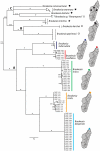


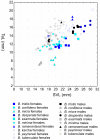
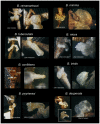

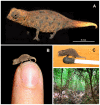
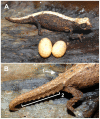

References
-
- Hedges SB, Thomas R. At the lower size limit in amniote vertebrates: a new diminutive lizard from the West Indies. Caribb J Sci. 2001;37:168–173.
-
- Hedges SB. At the lower size limit in snakes: two new species of threadsnakes (Squamata: Leptotyphlopidae: Leptotyphlops) from the Lesser Antilles. Zootaxa. 2008;1841:1–30.
-
- Hanken J, Wake DB. Miniaturization of body-size: organismal consequences and evolutionary significance. Annu Rev Ecol Syst. 1993;24:501–519.
-
- Yeh J. The effect of miniaturized body size on skeletal morphology in frogs. Evolution. 2002;56:628–641. - PubMed
-
- Glaw F, Vences M, Ziegler T, Böhme W, Köhler J. Specific distinctness and biogeography of the dwarf chameleons Brookesia minima, B. peyrierasi and B. tuberculata (Reptilia: Chamaeleonidae): evidence from hemipenial and external morphology. J Zool. 1999;247:225–238.
Publication types
MeSH terms
LinkOut - more resources
Full Text Sources

